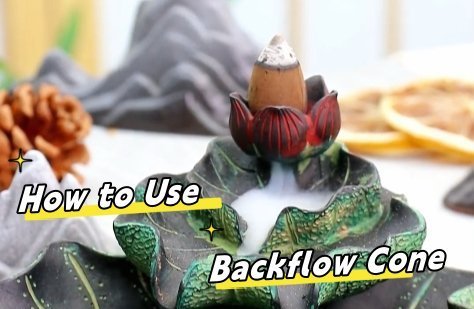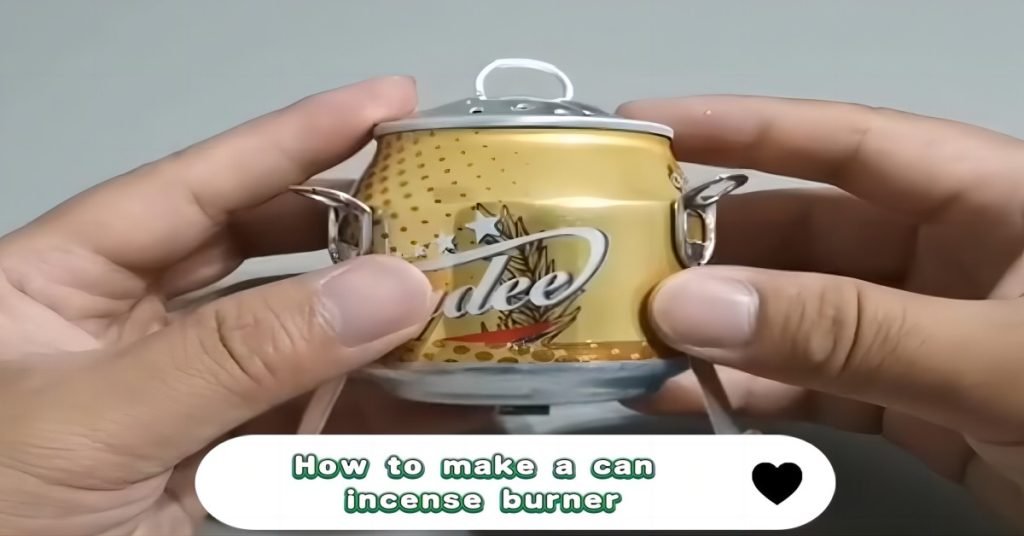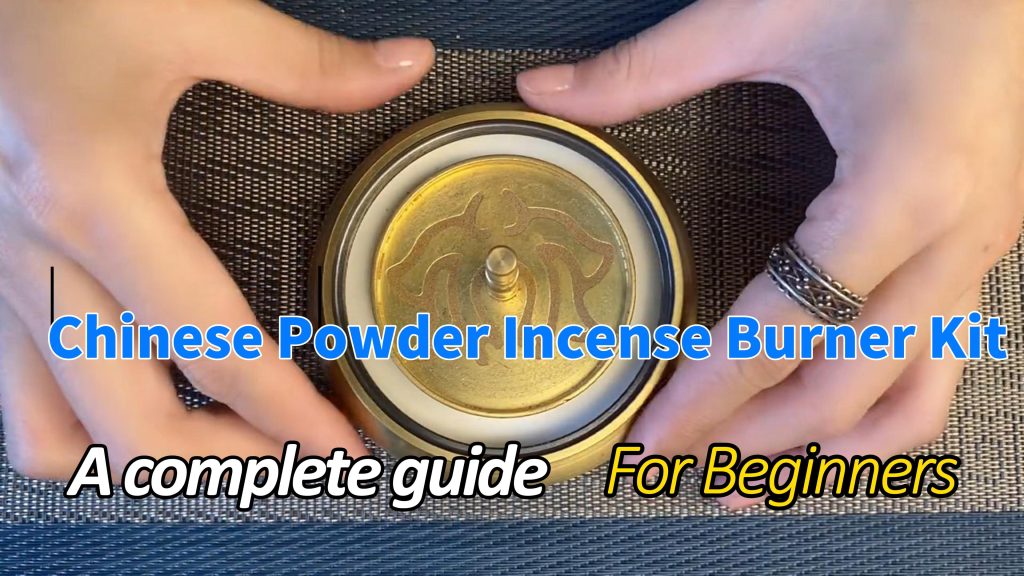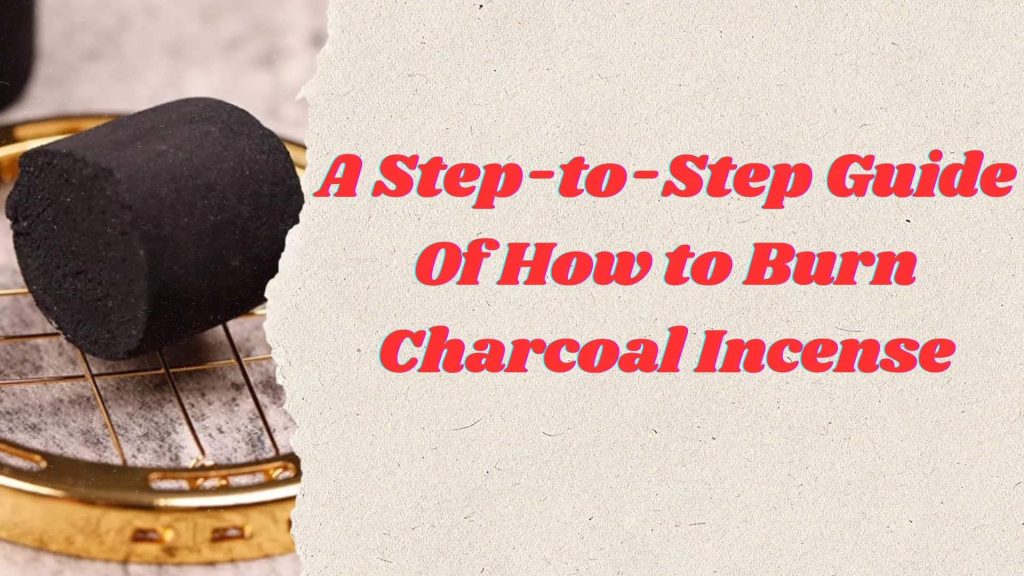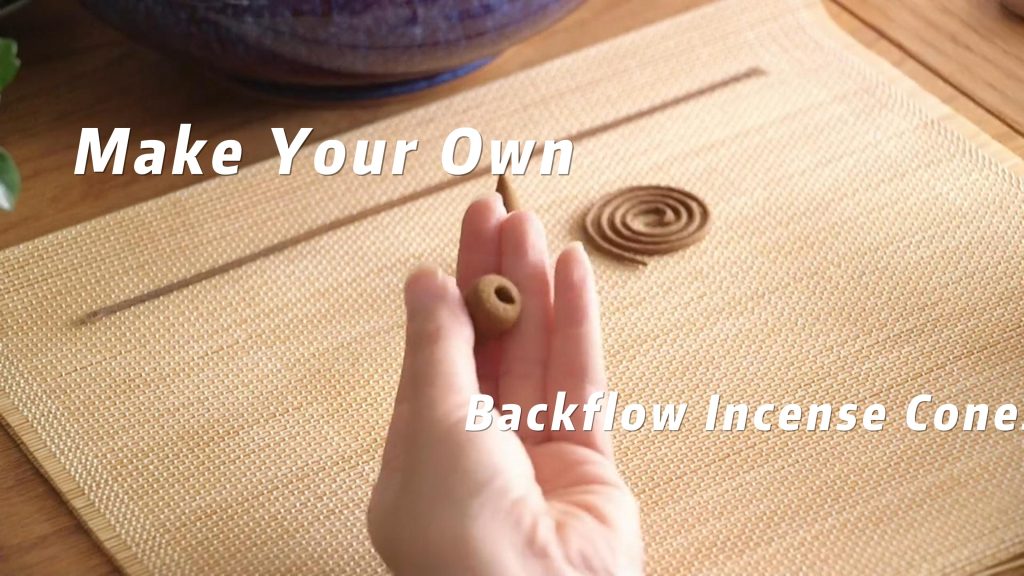Introduction
Backflow incense cones have gained popularity for their captivating visual effect, where the smoke mysteriously flows downward, creating a waterfall-like appearance. Unlike traditional incense, where the smoke rises into the air, backflow incense adds an extra layer of ambiance, perfect for meditation, relaxation, or simply enhancing your home’s atmosphere. This article will give you guide of how backflow incense burners work, how to use backflow incense cones and burners, and how to clean backflow incense burners.
Is Backflow Incense Safe?
Backflow incense or waterfall incense cone is generally safe to use. However, like any product that involves burning, it’s important to take a few precautions to ensure safety and avoid any potential risks. Here are some key safety considerations:
- Proper Ventilation: Backflow incense releases smoke and, depending on the ingredients, it may contain particles that could irritate sensitive individuals. Always burn incense in a well-ventilated space to prevent smoke buildup, especially if you have respiratory issues or allergies.
Use Heat-Resistant Burners: Make sure to use a heat-resistant burner specifically designed for backflow incense cones. These burners are made to handle the high temperatures from the burning cone, reducing the risk of damage to surfaces or accidental fires.
Keep Away from Flammable Objects: Ensure that your burner is placed on a stable, non-flammable surface and away from any flammable objects like curtains, paper, or fabrics. Always keep your burning incense within sight to prevent accidents.
Monitor the Smoke: While backflow incense cones produce a stunning visual effect, inhaling large amounts of incense smoke may not be healthy over extended periods. Try to limit exposure to the smoke, and avoid placing the burner directly under your nose or in enclosed spaces without adequate airflow.
Keep Away from Children and Pets: Like all burning products, backflow incense cones should be kept out of reach of children and pets. The burners can get hot, and the smoke, while beautiful, could be irritating or hazardous if touched or inhaled too closely by pets or small children
To learn more about this topic in detail, you can read our article Is Burning Incense Safe?
Backflow Incense Cones & Burners vs Regular Ones
Before you start enjoying the mesmerizing waterfall effect of backflow incense cones, you’ll need to gather a few essential items to ensure a smooth and safe experience. The above video gives a detailed intro on the topic of backflow incense cones vs regular. You have to use backflow incense cones and specially designed burners. Here’s a quick list of their differences with ordinary ones:
Backflow Incense Cones vs Ordinary Incense Cones
While both backflow and normal incense cones serve the purpose of releasing fragrant smoke when burned, there are some key differences in design, effect, and usage:
- Difference in Design: Backflow incense cones have a hollow tunnel running through the center, allowing the smoke to flow downward. Regular incense cones are solid and release smoke upward as the incense burns.
- Difference in Smoke Flow: Backflow cones create a cascading, downward smoke flow, designed to work with specialized burners for a visual effect. Regular cones produce smoke that rises naturally, spreading freely into the air.
- Difference in Usage Purpose: Backflow incense is favored for creating a calming, meditative ambiance, combining both fragrance and the visual appeal of cascading smoke. Regular incense is typically used in settings where the focus is primarily on scent, such as rituals or aromatherapy
If you want to customize your backflow incense cones and make your own backflow incense cones, you can read our article How to Make Backflow Incense Cones.
Backflow Incense Cone Burners vs Regular Cone Incense Burners
While both backflow incense burners and regular cone incense burners serve the function of holding incense and directing the smoke, there are distinct differences between the two based on their design, purpose, and the visual effect they create:
- Difference in Smoke Direction: Backflow incense burners guide the smoke downward through a hole in the cone, creating a waterfall effect. Regular burners let the smoke rise naturally without directing its movement.
- Difference in Burner Design: Backflow burners are often artistic, with features like steps or curves to enhance the smoke’s flow. Regular burners are simpler, designed to hold the cone and catch ash with a focus on function over decoration.
If you want to learn more about their differences, you can read our article Backflow Incense Cones vs Regular Cones.
How Backflow Incense Cones and Burners Work? Understand the Science Behind Backflow Incense
The above video explains what is the science behind backflow waterfall incense burners. Here is a detailed explanation of how backflow incense burners work:
Under normal circumstances, smoke rises due to thermal convection. When you light something, the surrounding air heats up, and because warm air is lighter than cool air, it rises, carrying the smoke with it. This is the familiar pattern we see with traditional incense or any other burning material.
However, reverse waterfall incense cones are specially designed to reverse this effect. For people wanting to know what is the science behind backflow incense cones, the key to this downward flow lies in the shape and structure of the incense cone. Unlike regular cones, backflow cones have a small hollow section inside, often compared to a pagoda or a small tunnel. This design plays a crucial role in manipulating the airflow.
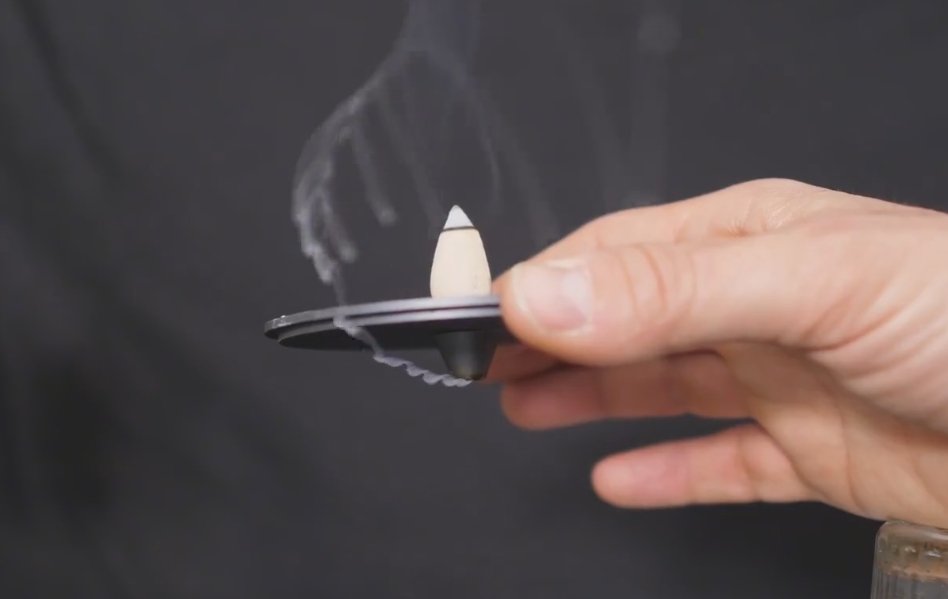
As the incense burns, the heat inside the hollow space creates a low-pressure zone. At the same time, cooler air from outside exerts pressure on the smoke. Once the smoke reaches the small hole at the base of the cone, it slows down, and instead of rising, it gets pushed downward by the cooler, denser air from above.
The smoke then flows gracefully down the backflow incense burner, creating a mesmerizing, waterfall-like effect. The downward path is guided by the specific design of the burner, often crafted to direct the smoke along intricate slopes or steps, adding to its visual appeal.
How to Light and Burn Backflow Incense Cones
The above video uses wooden cow backflow incense burner as an example and explains how to use backflow incense burners and how to light backflow incense cones. Here is a detailed guide of how to light and burn backflow waterfall incense cones as well as how to use a backflow incense burner:
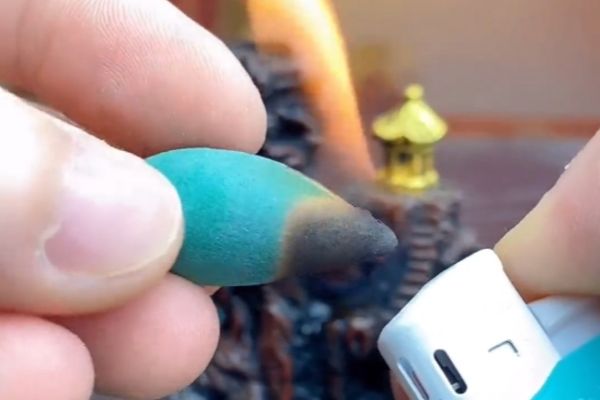
Step 1: Properly Light the Incense Cone
- Begin by holding the incense cone with the pointed end facing upward and the flat, hollow end at the bottom. This ensures the hollow part will properly channel the smoke downward once it’s lit.
- Use a lighter or match to light the pointed tip of the incense cone. Allow the tip to catch fire and burn for about 4–5 seconds, or until you see a steady flame.
- Let the flame burn for a few more moments (about 4mm of the tip should burn) to ensure the incense is fully ignited. This step is crucial to creating a steady, long-lasting ember that will produce continuous smoke.
- After the tip has been burning for a short while, gently blow out the flame. The cone should no longer have an open flame but should glow red, indicating that it has a steady ember. The ember is what will release the smoke as the cone continues to burn slowly from the top down
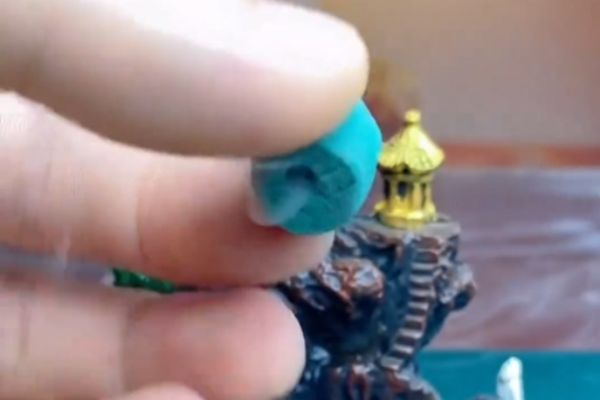
Step 2: Ensure Smoke Flows from the Base
- Once the ember is glowing, observe the cone closely to ensure that smoke is flowing through the hollow hole at the base of the cone. This is a key feature of backflow incense cones that enables the unique downward smoke effect.
- It may take a few seconds for the smoke to begin flowing from the bottom. If you notice the smoke coming from the tip instead of the base, check the ember and relight the cone if necessary to ensure the proper burn.
- When properly lit, the smoke will start to gently flow down from the bottom of the cone, creating the iconic backflow effect

Step 3: Align the Cone with the Burner Hole
- Carefully place the lit incense cone onto the backflow incense burner. Ensure the hole at the base of the cone aligns perfectly with the designated hole or indentation on the backflow incense burner. This is crucial for guiding the smoke down the burner’s channels or slopes.
- Misalignment can prevent the smoke from traveling properly, disrupting the visual flow of the backflow effect. Take a moment to check that the cone is securely seated on the burner and properly aligned with the airflow design
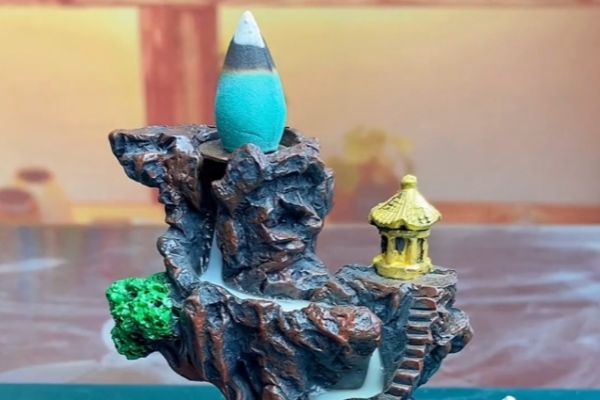
Step 4: Use in a Wind-Free Environment
- For the best experience, place the backflow incense burner in an indoor environment free from wind or drafts. Even minor air movement from windows, fans, or air conditioning can interrupt the downward smoke flow, causing it to disperse instead of flowing smoothly.
- Position the burner on a flat surface, away from air vents, doors, or windows, to maintain a consistent backflow effect. This will ensure that the smoke cascades downward without being disturbed, allowing you to fully enjoy the relaxing, tranquil visual experience.
- If you notice the smoke wavering or failing to flow down, check for any air movement and relocate the burner to a calmer spot if necessary
The above video gives a more detailed intro of how to light waterfall incense cones.
Special Cautions for Successfully Lighting Backflow Incense Cones
While learning how to light your waterfall incense and how to use your waterfall incense burner, you have to pay special attention to the followings:
Don’t Overheat the Cone: Avoid holding the flame on the incense cone for too long. Overheating the cone can cause it to burn too quickly, reducing the backflow effect and the overall burn time. Once the tip is lit and glowing, blow out the flame promptly.
Ensure Proper Ember Formation: After lighting, make sure the incense cone forms a steady, glowing ember. If the ember isn’t properly formed, the cone may go out too quickly, or the smoke may not flow from the base as intended. If the ember goes out prematurely, relight the cone and try again.
Check Alignment with Burner: Always ensure that the hole at the base of the incense cone is aligned with the hole or groove on the backflow burner. Misalignment will prevent the smoke from flowing downward and disrupt the backflow effect.
Avoid Using in Drafty Areas: Keep the burner away from fans, vents, windows, or drafts. Even small air currents can interfere with the backflow incense’s downward smoke, causing it to rise or disperse instead of flowing smoothly down the burner.
Be Mindful of Burn Time: Backflow incense cones burn more quickly than traditional cones due to their hollow structure. Monitor the cone as it burns to ensure it doesn’t extinguish prematurely, and never leave it unattended for long periods.
By following strictly the steps mentioned above and pay attention to the five cautions, then you will quickly learn how to set up your backflow incense burner quickly.
How to Put Out Backflow Incense Cones?
Compared with putting out incense sticks, it is usually much harder to put out a backflow incense cones. If you need to extinguish a backflow incense cone before it burns out completely, follow these steps to safely put it out without creating a mess or damaging the cone:
Gently Blow on the Ember: If you want to stop the incense from burning, you can gently blow on the glowing ember. This may cause the ember to extinguish, but it’s important to do so carefully to avoid scattering ash or blowing the cone out of alignment.
Snuff It Out: A more reliable method to extinguish the cone is to snuff it out by covering the ember with a heat-resistant object, like a small metal or ceramic cap. The lack of oxygen will extinguish the ember without creating too much smoke or debris. Ensure that the object you use is safe for high temperatures.
Dip the Cone in Water (As a Last Resort): If the cone is difficult to extinguish or you need to put it out quickly, you can dip the tip of the cone in water. This will stop the burn immediately, but note that this method will ruin the rest of the cone, making it unusable for future burning. Only use this method if you don’t plan to relight the cone.
How to Dispose of the Ashes of Backflow Incense Cones?
After burning a backflow incense cone, you’ll be left with ash and residue, which should be properly disposed of to maintain cleanliness and prevent any potential hazards. Here are a few tips you can follow to do with the residue or white ashes left by the burnt backflow incense cones:
Wait for the Cone to Cool:
Ensure the incense cone has fully burned and the burner has cooled before handling the ash. Even after burning, embers may remain hot, so allow adequate time to cool.Remove the Ash:
Gently tap or brush the ash from the burner into a heat-resistant container or trash bin. Use a soft cloth or brush to avoid damaging the burner.Check for Residue:
Some burners may have sticky residue from the incense. For stubborn spots, use a damp cloth or soft-bristle brush to clean the burner’s surface and intricate areas.Disposal Options:
- Natural Incense Ash: If using incense made from natural materials (such as wood, resins, or herbs), the ash can be composted or scattered in your garden.
- Synthetic Incense Ash: If the incense contains synthetic materials or chemicals, dispose of the ash in the regular trash to avoid potential harm to the environment.
The four tips written above are merely four brief tips. If you want to learn more about this topic, you can read our article What to Do With Incense Ashes?
Conclusion
Backflow incense cones offer a unique and mesmerizing experience that goes beyond traditional incense burning. With their delicate downward smoke flow, they not only fill your space with calming aromas but also create a beautiful, meditative visual display. By following the steps outlined in this guide—choosing the right burner, properly lighting the cone, and ensuring the correct environment—you can enhance your backflow incense experience to its fullest potential. Whether you’re using them for relaxation, meditation, or simply to add a touch of beauty to your space, backflow incense cones are a perfect way to combine sensory pleasure with aesthetic appeal. Remember to handle them carefully, use them in a wind-free environment, and follow the safety precautions to fully enjoy the peaceful ambiance they provide.
Frequently Asked Questions
Generally, backflow incense cones burn for about 12 to 15 minutes. However, the exact burn time can vary depending on factors such as the size of the cone, the environment, and airflow in the room. While the burn time is relatively short, backflow cones provide a rich, aromatic experience, along with the soothing visual effect of the downward-flowing smoke, making them ideal for moments of relaxation or meditation
If your backflow incense is burning upwards or if you find your backflow incense burner not working, it’s likely due to one of the following issues:
Incorrect Placement: Ensure that the incense cone’s hole at the base is properly aligned with the hole or designated area on the burner. The cone must sit securely on the burner so the smoke can flow down through the hollow center.
Improper Lighting: The cone needs to be lit correctly for the backflow effect to work. Allow the tip of the cone to catch fire, and after blowing out the flame, ensure the ember is glowing steadily. If the cone isn’t fully ignited, the smoke might rise rather than flow down.
Airflow Interference: Strong air currents from fans, vents, or windows can disturb the downward smoke flow. Even slight drafts can cause the smoke to rise rather than cascade down. Make sure the burner is placed in a wind-free area for the proper backflow effect.
By addressing these factors, you should be able to enjoy the intended downward smoke flow from your backflow incense
No, not all incense cones are backflow. Backflow incense cones are specifically designed with a hollow hole at the bottom, which allows the smoke to flow downward, creating the unique backflow effect. In contrast, regular incense cones are solid throughout, and their smoke naturally rises upward when burned. To achieve the mesmerizing cascading smoke effect, you’ll need to use backflow incense cones with a compatible backflow incense burner. Regular cones will not produce the same visual effect, as their smoke disperses into the air without following a downward path
No, you cannot turn regular incense cones into backflow cones. Backflow incense cones are specially designed with a hollow tunnel running through their center, which allows the smoke to flow downward. This design is essential for creating the signature backflow effect. Regular incense cones are solid and lack this hollow structure, meaning the smoke will always rise when they are burned.
Attempting to modify a regular cone to mimic a backflow cone’s design is unlikely to work effectively, as the specific airflow dynamics required for the backflow effect depend on the precise structure of the cone. To enjoy the downward smoke flow, you will need to use authentic backflow incense cones with a properly designed burner
Although you can throw away incense ash, it actually has several useful applications! For example, incense ash can be used as a natural fertilizer for plants, as it contains minerals that can enrich the soil. Simply sprinkle a small amount around your plants to help them thrive. Additionally, incense ash can be used to clean grease or oil stains. The fine texture of the ash can help absorb oils, making it easier to clean up messes. Rather than discarding it, consider these practical ways to reuse your incense ash around the house and garden. To learn more how to use incense ashes efficiently, you can read our article What To Do With Incense Ashes?

